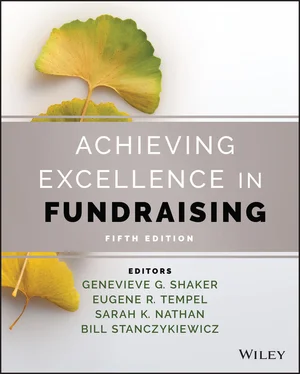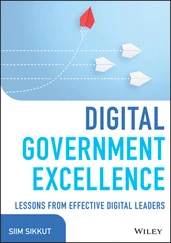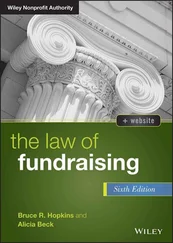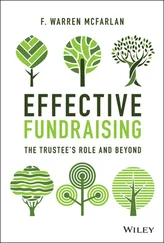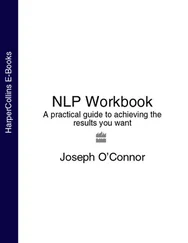Achieving Excellence in Fundraising
Здесь есть возможность читать онлайн «Achieving Excellence in Fundraising» — ознакомительный отрывок электронной книги совершенно бесплатно, а после прочтения отрывка купить полную версию. В некоторых случаях можно слушать аудио, скачать через торрент в формате fb2 и присутствует краткое содержание. Жанр: unrecognised, на английском языке. Описание произведения, (предисловие) а так же отзывы посетителей доступны на портале библиотеки ЛибКат.
- Название:Achieving Excellence in Fundraising
- Автор:
- Жанр:
- Год:неизвестен
- ISBN:нет данных
- Рейтинг книги:5 / 5. Голосов: 1
-
Избранное:Добавить в избранное
- Отзывы:
-
Ваша оценка:
- 100
- 1
- 2
- 3
- 4
- 5
Achieving Excellence in Fundraising: краткое содержание, описание и аннотация
Предлагаем к чтению аннотацию, описание, краткое содержание или предисловие (зависит от того, что написал сам автор книги «Achieving Excellence in Fundraising»). Если вы не нашли необходимую информацию о книге — напишите в комментариях, мы постараемся отыскать её.
Achieving Excellence in Fundraising
Achieving Excellence in Fundraising
Achieving Excellence in Fundraising
Achieving Excellence in Fundraising — читать онлайн ознакомительный отрывок
Ниже представлен текст книги, разбитый по страницам. Система сохранения места последней прочитанной страницы, позволяет с удобством читать онлайн бесплатно книгу «Achieving Excellence in Fundraising», без необходимости каждый раз заново искать на чём Вы остановились. Поставьте закладку, и сможете в любой момент перейти на страницу, на которой закончили чтение.
Интервал:
Закладка:
Table of Contents
1 COVER
2 TITLE PAGE ACHIEVING EXCELLENCE IN FUNDRAISING FIFTH EDITION EDITORS GENEVIEVE G. SHAKER EUGENE R. TEMPEL SARAH K. NATHAN BILL STANCZYKIEWICZ
3 COPYRIGHT
4 LIST OF TABLES, FIGURES, AND EXHIBITSTables Figures Exhibits
5 FOREWORD
6 PREFACE A Strong Tradition A New Era The New Edition A Contribution to Philanthropy
7 ACKNOWLEDGMENTS
8 THE EDITORS
9 AUTHOR BIOS
10 PART ONE: PHILANTHROPIC CONCEPTS FOR FUNDRAISING CHAPTER ONE: DEVELOPING A PERSONAL PHILOSOPHY OF FUNDRAISING Why a Philosophy of Fundraising? Personal Experiences and Philanthropy Philanthropy in Society Core Fundraising Tenants within Organizations Conclusion Discussion Questions Application Exercises CHAPTER TWO: A COMMITMENT TO ETHICAL FUNDRAISING A Foundation of Trust Philosophy of Ethics Professional Ethics Ethical Behavior Applying Ethics Ethics and Social Justice Conclusion Discussion Questions Application Exercises CHAPTER THREE: LEGAL ASPECTS OF FUNDRAISING Background Governance State Law Considerations Federal Law Considerations Tax Benefits for Charitable Giving Conclusion Discussion Questions Application Exercises CHAPTER FOUR: THEORY IN FUNDRAISING Theory's Role in Fundraising Practice Theoretical Approaches Conclusion Discussion Questions Application Exercises CHAPTER FIVE: THE JOY OF GIVING Psychological Outcomes Social Outcomes Physical Outcomes The Joy of Giving around the World The Joy of Giving across the Lifespan The Joy of Giving during Difficult Times The Limits of Giving More Joyful Giving Conclusion Discussion Questions Application Exercises
11 PART TWO: CONTEMPORARY DYNAMICS OF FUNDRAISING CHAPTER SIX: THE PHILANTHROPIC CONTEXT FOR FUNDRAISING Defining Philanthropy The Contemporary Challenges Philanthropy Faces Size and Scope Technological and Educational Advances in Philanthropy Infrastructure Fundraising and the Economic, Social, and Political Climate Opportunities for Philanthropy Conclusion Discussion Questions Application Exercises CHAPTER SEVEN: FUNDRAISING IN CHALLENGING TIMES: CRISIS, SURVIVAL, AND TRANSFORMATION Fundraising Is Never Far from a Crisis Leadership Habits in Crisis Fundraising: Purpose, Power, and Perspective The Demand for Perspective: The Mindful Work of Fundraising Conclusion Discussion Questions Application Exercises CHAPTER EIGHT: FUNDRAISING ACROSS NONPROFIT SUBSECTORS Religion Education Human Services Foundations Public‐Society Benefit Health International Affairs Arts, Culture, and Humanities Environment and Animals Conclusion Discussion Questions Application Exercises CHAPTER NINE: GLOBAL PHILANTHROPY AND CROSS‐CULTURAL FUNDRAISING Global Perspectives on Philanthropy Global Development of Fundraising Cultural Influences and Fundraising in the United States Implementing Fundraising Principles across Cultures Conclusion Discussion Questions Application Exercises CHAPTER TEN: FUNDRAISING FOR ADVOCACY AND SOCIAL CHANGE Amplifying Social Movements Fundraising Trends during COVID‐19 and the Racial Justice Movement Fundraising Resulting from Advocacy for Social Change Conclusion Discussion Questions Application Exercises
12 PART THREE: AN ORGANIZATIONAL FOUNDATION FOR FUNDRAISING CHAPTER ELEVEN: PREPARING THE ORGANIZATION FOR FUNDRAISING Capable Human Resources Comprehensive Planning A Commitment to Evaluation Fundraising Operational Requirements Connecting with the External Environment Conclusion Discussion Questions Application Exercise CHAPTER TWELVE: BUILDING A COMPREHENSIVE FUNDRAISING PROGRAM Development Planning and Communications The Fundraising Cycle The Four‐Legged Stool of Fundraising Donor Pyramid of Fundraising Strategies Conclusion Discussion Questions Application Exercises CHAPTER THIRTEEN: ARTICULATING A CASE FOR SUPPORT Defining Case for Support and Case Statement Preparing the Case for Support Key Information Components of a Case for Support Case Statements Tailored to the Audience and Supporting the Mission Conclusion Discussion Questions Application Exercises CHAPTER FOURTEEN: IDENTIFYING AND QUALIFYING POTENTIAL DONORS Introduction The Rosso Constituency Model The LAI Principle Qualifying Donors LIA, the Other Principle Prospective Donor Research Ethical Considerations Conclusion Discussion Questions Application Exercises CHAPTER FIFTEEN: BUDGETING AND EVALUATION IN FUNDRAISING Constructing the Fundraising Budget Creating the Fundraising Budget Evaluating Fundraising Programs with Measurement and Evaluation Tools Understanding Employee Time and the Fundraising Budget Conclusion Discussion Questions Application Exercises CHAPTER SIXTEEN: MARKETING FOR STRATEGIC FUNDRAISING Marketing as the Linchpin A Quick Guide to Branding Gathering Information to Build Relationships Incorporating Market Research Storytelling: Making Authentic, Long‐Term Connections Conclusion Discussion Questions Application Exercises CHAPTER SEVENTEEN: INTEGRATING PRINCIPLES OF DONOR RELATIONS What Is Donor Relations? Gift Acknowledgment Expressing Gratitude Stewardship and Donor Relations Transparency, Accountability, and Trust Donor Relations in Times of Crisis Diversity, Equity, and Inclusion (DEI) Conclusion Discussion Questions Application Exercises
13 PART FOUR: THE FUNDRAISING TEAM CHAPTER EIGHTEEN: FUNDRAISERS: STEWARDS OF PHILANTHROPY The Formalization of Fundraising Fundraisers and Their Work Fundraising as Art, Science, or Both? The Field's Challenges and Opportunities Conclusion Discussion Questions Application Exercises CHAPTER NINETEEN: FUNDRAISING PLANNING, MANAGEMENT, AND LEADERSHIP Management Leadership Power Fundraising Leadership during Times of Crisis Conclusion Discussion Questions Application Exercises CHAPTER TWENTY: ENGAGING THE BOARD FOR FUNDRAISING Recruiting Board Members Retaining Board Members Requesting Support from Board Members Conclusion Discussion Questions Application Exercises CHAPTER TWENTY‐ONE: WORKING WITH VOLUNTEER FUNDRAISERS Strategic Role and Value of Volunteer Fundraisers Volunteer Trends Volunteer Motivations Six Steps for Successful Volunteer Fundraiser Involvement Conclusion Discussion Questions Application Exercises
14 PART FIVE: BUILDING AND SUPPORTING THE DONOR BASE CHAPTER TWENTY‐TWO: THE ANNUAL GIVING PROGRAM All Gifts Matter Annual Giving Tools for Annual Fund Planning Annual Fund Concerns Conclusion Discussion Questions Application Exercises CHAPTER TWENTY‐THREE: CRAFTING COMPELLING APPEALS What Is a Compelling Appeal? Differentiating Appeals for Distinct Audiences Research‐Informed Strategies for Developing the Message Planning the Call to Action Deploying Effective Appeals Writing Ethical Appeals Conclusion Discussion Questions Application Exercises CHAPTER TWENTY‐FOUR: DEVELOPING DIGITAL FUNDRAISING STRATEGIES Managing Digital Content Strategy Crowdfunding Basics Digital Tools and Considerations Acceleration of Digital Adoption in a Pandemic Conclusion Discussion Questions Application Exercises CHAPTER TWENTY‐FIVE: PLANNING EVENTS WITH PURPOSE Differentiating Events by Purpose Critical Factors for Event Success Considering Internal Event Dynamics Conclusion Discussion Questions Application Exercises
15 PART SIX: ENGAGING THE DIVERSITY OF INDIVIDUAL DONORS CHAPTER TWENTY‐SIX: UNDERSTANDING INDIVIDUAL DONORS Resources for Giving How Socio‐demographic Characteristics Relate to Giving The Complex Dynamics of Individual Giving Behavior Implications for Practice: Assessing Donor Motivations Conclusion Discussion Questions Application Exercises CHAPTER TWENTY‐SEVEN: THE ROLE OF RELIGION IN GIVING The Landscape of Religious Giving Religious Giving Motivations and Perspectives Fundraising within a Religious Context Faith and Fundraising Conclusion Discussion Questions Application Exercises CHAPTER TWENTY‐EIGHT: WOMEN AND PHILANTHROPY The Potential of Women as Donors Challenging Assumptions Identifying How and Why Women Give Conclusion: A New Era in Women's Philanthropy Discussion Questions Application Exercises CHAPTER TWENTY‐NINE: PHILANTHROPY AMONG COMMUNITIES OF COLOR The Context of U.S. Racial/Ethnic Diversity Examining Philanthropy in Communities of Color Research about Philanthropy in Communities of Color Toward Inclusive Philanthropy Conclusion Discussion Questions Application Exercises CHAPTER THIRTY: LGBTQ PHILANTHROPY Expanding LGBTQ Rights: An Evolving Movement LGBTQ Patterns of Giving LGBTQ Motivations for Giving Household Financial Management and LGBTQ Giving Recommendations for Equitable and Inclusive Fundraising Conclusion Discussion Questions Application Exercises CHAPTER THIRTY‐ONE: DIFFERENTIATING GENERATIONS AND THEIR GIVING Generational Changes Life Course Development Organizational Engagement and Social Capital Giving across Generations Data Conclusion Discussion Questions Application Exercise CHAPTER THIRTY‐TWO: HIGH NET WORTH HOUSEHOLD GIVING INSIGHTS Context and Patterns of Charitable Behavior Giving Motivations and Decision‐Making Policy Issues Implications for Fundraisers Conclusion Discussion Questions Application Exercises
Читать дальшеИнтервал:
Закладка:
Похожие книги на «Achieving Excellence in Fundraising»
Представляем Вашему вниманию похожие книги на «Achieving Excellence in Fundraising» списком для выбора. Мы отобрали схожую по названию и смыслу литературу в надежде предоставить читателям больше вариантов отыскать новые, интересные, ещё непрочитанные произведения.
Обсуждение, отзывы о книге «Achieving Excellence in Fundraising» и просто собственные мнения читателей. Оставьте ваши комментарии, напишите, что Вы думаете о произведении, его смысле или главных героях. Укажите что конкретно понравилось, а что нет, и почему Вы так считаете.
